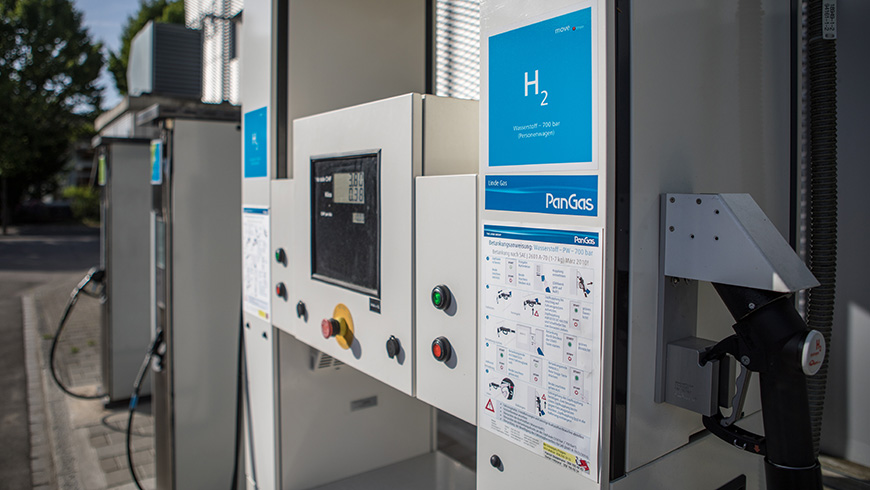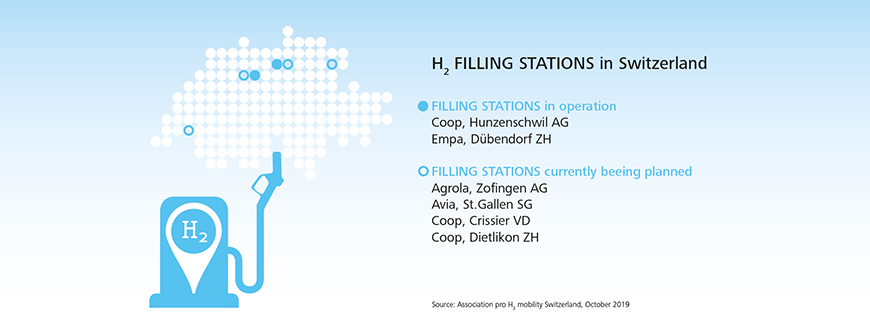Guideline for approval procedures
A step-by-step guide to build hydrogen filling stations
Hydrogen is considered a promising solution for mobility without fossil fuels. What is still missing, however, is a nation-wide network of fueling stations. One reason for this: The approval procedure for the planning and construction of hydrogen filling stations is still very confusing, as experience is largely lacking. In order to clarify this issue, Empa, together with various partner institutions, has drawn up an approval guideline for builders of filling stations, authorities and specialist agencies – thus paving the way for a nation-wide hydrogen filling station network.

There are currently only two hydrogen filling stations for passenger cars in Switzerland. One is at Empa's "move" mobility demonstrator in Dübendorf, the other one in Hunzenschwil in the canton of Aargau. Both filling stations are the result of a cooperation between Empa, the Swiss Federal Office of Energy (SFOE), "H2 Energy" and Hyundai. "The development of these first hydrogen filling stations in Switzerland has shown that the approval procedure and the compilation of the relevant legal provisions are a challenge both for filling station planners and for authorities," says Christian Bach, head of Empa's Automotive Powertrain Technologies lab.
Therefore, Bach and his team have worked together with the relevant specialist bodies and authorities to develop guidelines for the construction of hydrogen filling stations, which the Swiss Association for Standardization (SNV) recently published (Swiss Guideline SNG 10000:2019) and distributes free of charge via its online shop. Step by step, the guideline breaks down which authorities and organisations should be involved in the approval procedure in Switzerland and what has to be taken into account during planning and construction. It also provides an overview of the relevant national and international laws, regulations and standards. The guideline is of an informal nature and is not legally binding.

A simpler way to hydrogen filling stations
"With this guideline, we would like to provide support to filling station builders and authorities and thus simplify the planning and construction of hydrogen filling stations," says Bach. For many years, the mobility researcher and his team have been working on the transition from fossil to renewable energy and the associated potential to significantly reduce CO2 emissions from road traffic. In addition to electromobility, the focus is on hydrogen and synthetic fuels. In view of the steady expansion of photovoltaics in Switzerland, these forms of mobility are likely to play an increasingly important role in the future. Hydrogen is also a central element of the new energy strategy, as it offers the possibility of temporarily transferring excess electricity from hydroelectric power stations or solar power plants – which is generated in large quantities in the summer months – to other energy sectors such as mobility. This electricity is first converted into hydrogen by water electrolysis and is then available for refuelling fuel cell vehicles; at the same time, this is the first stage of so-called power-to-gas technology.
The filling station of the future
Since 2015, Empa has been operating its "move" research and technology transfer platform together with partners from the public sector and industry. Designed as the charging and fueling station of the future, "move" allows electric, hydrogen and gas vehicles to be refuelled and the advantages and drawbacks of these three mobility paths to be explored.
The Swiss Guideline SNG 10000:2019 " Leitfaden zum Aufbau von Wasserstoff-Tankstellen" is available (in German only) for free download in the online shop of the Swiss Association for Standardization (SNV). For the time being, the guide is only available in German.
In the course of implementing the first Swiss hydrogen filling stations, Empa researchers not only clarified technical issues, but also safety issues. It should be as easy as possible to integrate a hydrogen filling station into a regular fuel station. A standardized leak test before each hydrogen filling should enable a space-efficient design and still guarantee safety at filling stations with hydrogen filling pumps. To the media release "How to make hydrogen filling stations safer" (26.06.2019)
| Audio |

Radio programme on SRF2 Kultur, Wissenschaftsmagazin, of 22 October 2019
-
Share
